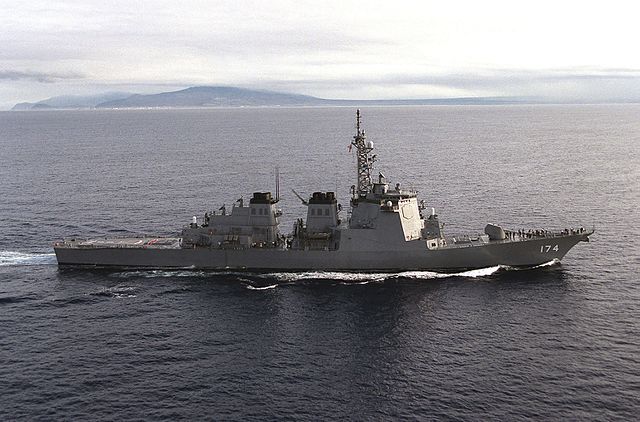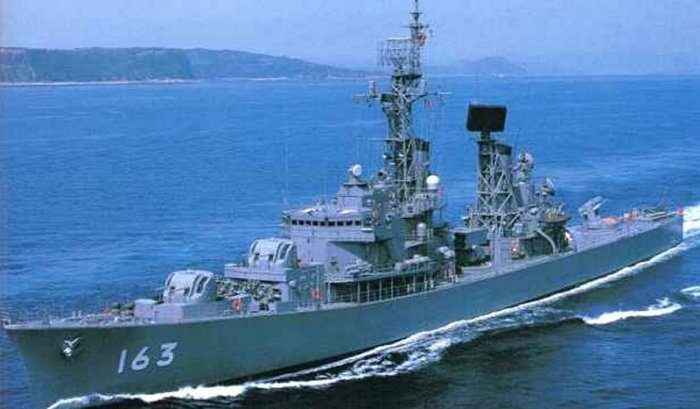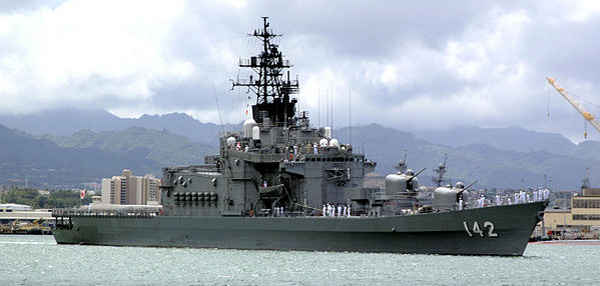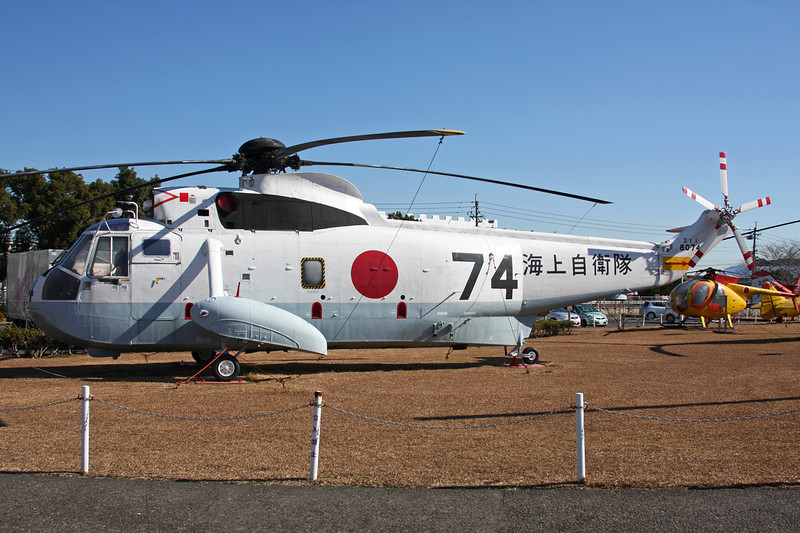The Japan Maritime Self-Defense Force (海上自衛隊 Kaijō Jieitai), acronym JMSDF is the Japanese Navy born out of the war under American guidance and under treaty.
This was the maritime warfare branch of the Japan Self-Defense Forces. This force was bound by treaty as a strict defensive force, framed by a context of possible engagement against the USSR or communist China. After the dissolution of the Imperial Japanese Navy (IJN), the destruction of more than 95% of the old fleet, the new JMSDF had to start again from scratch. It happened that the Navy started with a mix of surplus American ships and leftovers of the IJN, either small ships launched in 1945 and having little service (like ASW patrollers) and some completed in shipyards.
 Izumo class carriers “helicopter destroyers”
Izumo class carriers “helicopter destroyers”
As of today, what is now currently known as the “Japanese Navy” by simplification could barely stand as “defensive” as its ships numbers and quality tends towards a regional blue water navy. As of particular interest are the latest “helicopter cruisers” like the izumo class (Izumo and Kaga), capable of operating the F-35 and succeeding to the Hyūga class. The main reasons are two folds: The new Abe government’s own policy, encouraged by the Pentagon and of course the rapid rise of PLAN and regional ambitions of China.
The JMSDF Yesterday and Now
Today the JMSDF boast a fleet of 154 ships and 346 aircraft manned by 45,800 personnel. Main missions are still to protect Japanese sea lanes and patrol territorial waters, also taking part in UN-led peacekeeping operations and Maritime Interdiction Operations. This naval force is one of the strongest in the world, with some of the largest and most powerful destroyers ever built, including some hybrids like the Hyūga and Izumo class helicopter destroyers and AEGIS-capable Kongo class DDs. Japan started early a policy of building standard destroyers assisted by a couple of helicopter destroyers of various capacities. These modern ships are just aircraft carriers in all but name, a considerable leap forward in blue water capabilities, well beyond a strict defensive framework. Indeed to this day Article 9 of the Japanese Constitution still forbid Japan to built any aircraft carrier.

JDS Kirishima, of the Kongo class AEGIS DDs
Constitution of the JMSDF (1 July 1954)
Between 1945 and 1954, about ten years of American occupation, Japan started with little resources barely sufficient to protect fishing areas. Dissolved by the Potsdam Declaration acceptance, the fleet was reduced to a collection of disarmed ships, some taken away as war reparation (to be blasted in nuclear tests in the American case). Others provided means for the repatriation of Japanese soldiers throughout the whole asia-pacific, plus minesweeping the home waters. This dagerous and tiedous task was given to the supervision of the Second Bureau of the Demobilization Ministry. The minesweers were transferred afterwards to the newly formed Maritime Safety Agency, maintaining resources adnd skills for the navy.
Japan’s 1947 Constitution Article 9 in particular stated “The Japanese people forever renounce war as a sovereign right of the nation and the threat or use of force as a means of settling international disputes.” This was interpreted as to allow only a self-defense force. But under Cold War pressures and forced United States alliance, Japan had to bring its own maritme assets to the local defence rather than relying only on the US Navy.
At last in 1952, the Coastal Safety Force was created, as part of the Japanese Maritime Safety Agency. It included the minesweeping fleet and auxiliary vessels including American transferred destroyers. Two years later, this Force was separated to become the core of the JMSDF, a simple branch of the Japanese Self-Defense Force (JSDF), fixated by a law.

Harukaze, the earliest Japanese cold war destroyer, as preserved.
In 1956, the JMSDF at last commissioned its first domestically produced destroyer, Harukaze. As the Cold War intensified, the JMSDF main task became the anti-submarine role. Both destroyers and frigates developed for the JMSDF were tailored for ASW warfare in priority. By 1970, this navy was sufficient in this frame to nor depend of the US Navy, which kept a permanent task force centered around a nuclear aircraft carrier. With Japan’s economy booming, the Navy also gradually benefited from constant increased in budget and by 1991 had achieved by tonnage an historical peak, both in quantity and quality of ships. They were perfectly able to take head on the Soviet Pacific fleet.
Composition of the coldwar JMSDF

Amatsukaze, the earliest modern Japanese missile destroyer, 1963.
This chapter has been already thoroughly examined in the cold war page, but in the space of 40 years, the fleet scrapped her US-built or supplied ships and restarted naval construction with its own industrial giants, like Mitsubishi, already responsible for Japan’s tanks and some of her planes. The main doctrine that dominated Japanese cold war thinking was its role of a shield against any infiltration of the Soviet Pacific fleet submarines, in particular SNA and SSBNs.
Early japanese DDs were clearly tailored for ASW warfare, a role that was pushed forward as a condition to benefit from the MDAP program. Japan therefore accessed in the 1950s to the latest in weapons and sensors tech. The strenght of the Japanese cold war navy entiely rested on submarines, that gradually were built in two classes: One helicopter destroyer, generally two ships dedicated to helicopter warfare, and a class of height more versatile destroyers, still helicopter capable but in a standard way. While the Harukaze, Ayanami, Murasame of the 1950s has been retired in 1990, the oldest Japanese DDs still active were the 1959 Akizuki class, of this early design (discarded 1993), and sole Amatsukaze (1963) that introduced a brand new Japanese DD design (discarded 1995). It was followed by the first class of ASW “escort destroyers”, the six Yamagumo class (1965-77). Moderately slow with their diesels, they were still capable of 27 knots and heavily armed for ASW warfare. Two became training ships in 1991, one an auxiliary, the others were still in service in the early 2000s.
The late 1960s will saw again a double class of four standard and three escort destroyers, the Takatsuki (1966-69) and Minegumo (1967-69). The first displaced 3100 tons, the second 2100 tons, 32 knots versus 27 knots. The first were heavily armed, but with slightly better antiship capabilities and more powerful electronics. The Minegumo were again ASW destroyers made for long range patrols. All were in service by 1990.

Helicopter Destroyer Hiei
1971 saw the arrival of the first Japanese Helicopter destroyer, Hiei. With on-board electronics being refined, airborne ASW warfare seemed a better solution and authorized the test of two massive destroyers, the largest postwar Japanese ships so far, bearing famous names also (used by former battleships): Hiei and Haruna. At 4700 tons standard, 6300 fully loaded, they were the largest and most powerful DDs in asia, capable of operating three large ASW HSS-2 heavy-duty long range helicopters.

Japanese Mitsubishi HSS-2 ASW and SAR helicopter (Licenced Sikorski S61).
Read More/Src
https://www.helis.com/database/model/Mitsubishi-Sea-King/
https://en.wikipedia.org/wiki/Japan_Maritime_Self-Defense_Force

 Latest Facebook Entry -
Latest Facebook Entry -  X(Tweeter) Naval Encyclopedia's deck archive
X(Tweeter) Naval Encyclopedia's deck archive Instagram (@navalencyc)
Instagram (@navalencyc)





 French Navy
French Navy Royal Navy
Royal Navy Russian Navy
Russian Navy Armada Espanola
Armada Espanola Austrian Navy
Austrian Navy K.u.K. Kriegsmarine
K.u.K. Kriegsmarine Dansk Marine
Dansk Marine Nautiko Hellenon
Nautiko Hellenon Koninklije Marine 1870
Koninklije Marine 1870 Marinha do Brasil
Marinha do Brasil Osmanlı Donanması
Osmanlı Donanması Marina Do Peru
Marina Do Peru Marinha do Portugal
Marinha do Portugal Regia Marina 1870
Regia Marina 1870 Nihhon Kaigun 1870
Nihhon Kaigun 1870 Preußische Marine 1870
Preußische Marine 1870 Russkiy Flot 1870
Russkiy Flot 1870 Svenska marinen
Svenska marinen Søværnet
Søværnet Union Navy
Union Navy Confederate Navy
Confederate Navy Armada de Argentina
Armada de Argentina Imperial Chinese Navy
Imperial Chinese Navy Marinha do Portugal
Marinha do Portugal Mexico
Mexico Kaiserliche Marine
Kaiserliche Marine 1898 US Navy
1898 US Navy Sovietskiy Flot
Sovietskiy Flot Royal Canadian Navy
Royal Canadian Navy Royal Australian Navy
Royal Australian Navy RNZN Fleet
RNZN Fleet Chinese Navy 1937
Chinese Navy 1937 Kriegsmarine
Kriegsmarine Chilean Navy
Chilean Navy Danish Navy
Danish Navy Finnish Navy
Finnish Navy Hellenic Navy
Hellenic Navy Polish Navy
Polish Navy Romanian Navy
Romanian Navy Turkish Navy
Turkish Navy Royal Yugoslav Navy
Royal Yugoslav Navy Royal Thai Navy
Royal Thai Navy Minor Navies
Minor Navies Albania
Albania Austria
Austria Belgium
Belgium Columbia
Columbia Costa Rica
Costa Rica Cuba
Cuba Czechoslovakia
Czechoslovakia Dominican Republic
Dominican Republic Haiti
Haiti Hungary
Hungary Honduras
Honduras Estonia
Estonia Iceland
Iceland Eire
Eire Equador
Equador Iran
Iran Iraq
Iraq Latvia
Latvia Liberia
Liberia Lithuania
Lithuania Mandchukuo
Mandchukuo Morocco
Morocco Nicaragua
Nicaragua Persia
Persia San Salvador
San Salvador Sarawak
Sarawak Uruguay
Uruguay Venezuela
Venezuela Zanzibar
Zanzibar Warsaw Pact Navies
Warsaw Pact Navies Bulgaria
Bulgaria Hungary
Hungary

 Bundesmarine
Bundesmarine Dutch Navy
Dutch Navy Hellenic Navy
Hellenic Navy Marina Militare
Marina Militare Yugoslav Navy
Yugoslav Navy Chinese Navy
Chinese Navy Indian Navy
Indian Navy Indonesian Navy
Indonesian Navy JMSDF
JMSDF North Korean Navy
North Korean Navy Pakistani Navy
Pakistani Navy Philippines Navy
Philippines Navy ROKN
ROKN Rep. of Singapore Navy
Rep. of Singapore Navy Taiwanese Navy
Taiwanese Navy IDF Navy
IDF Navy Saudi Navy
Saudi Navy Royal New Zealand Navy
Royal New Zealand Navy Egyptian Navy
Egyptian Navy South African Navy
South African Navy






























 Ukrainian Navy
Ukrainian Navy dbodesign
dbodesign